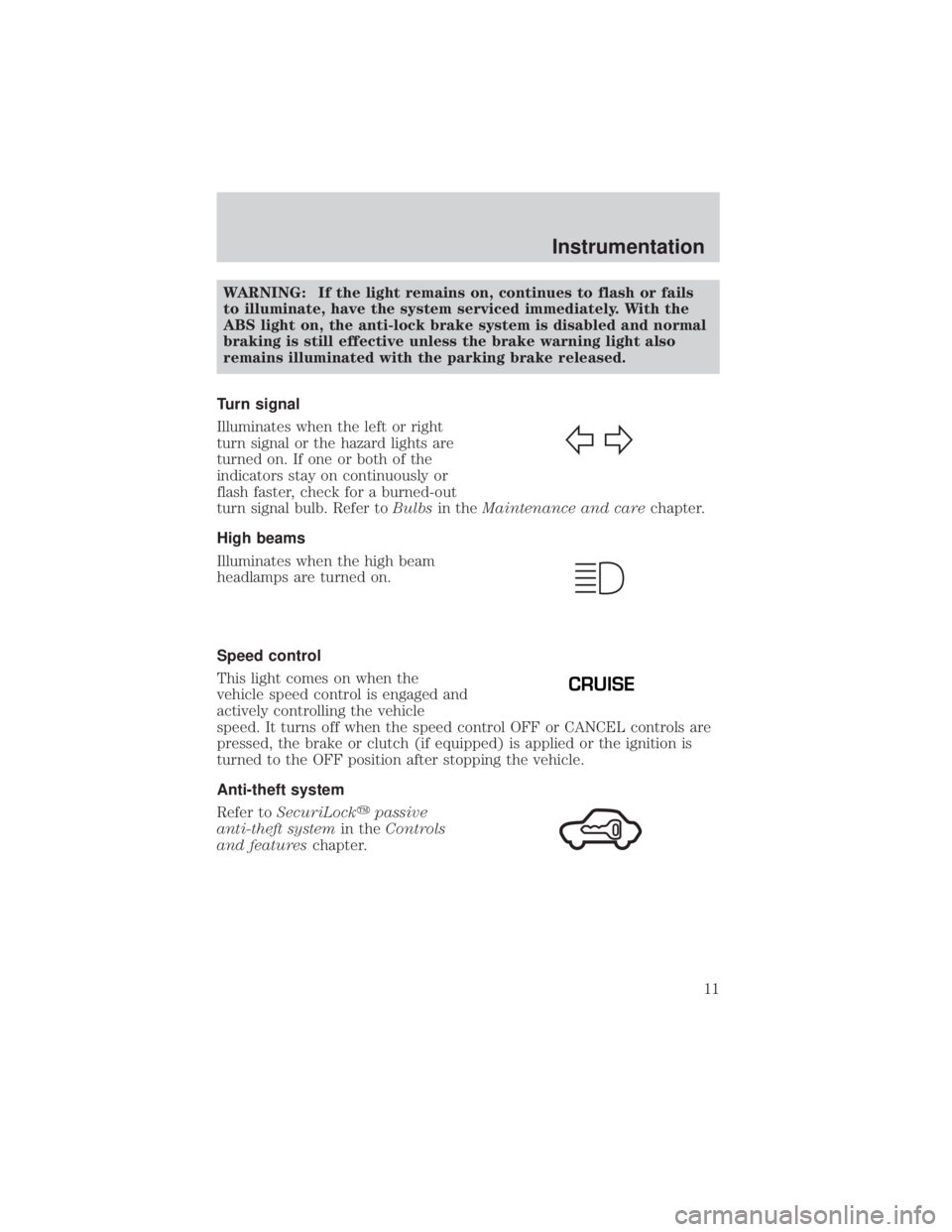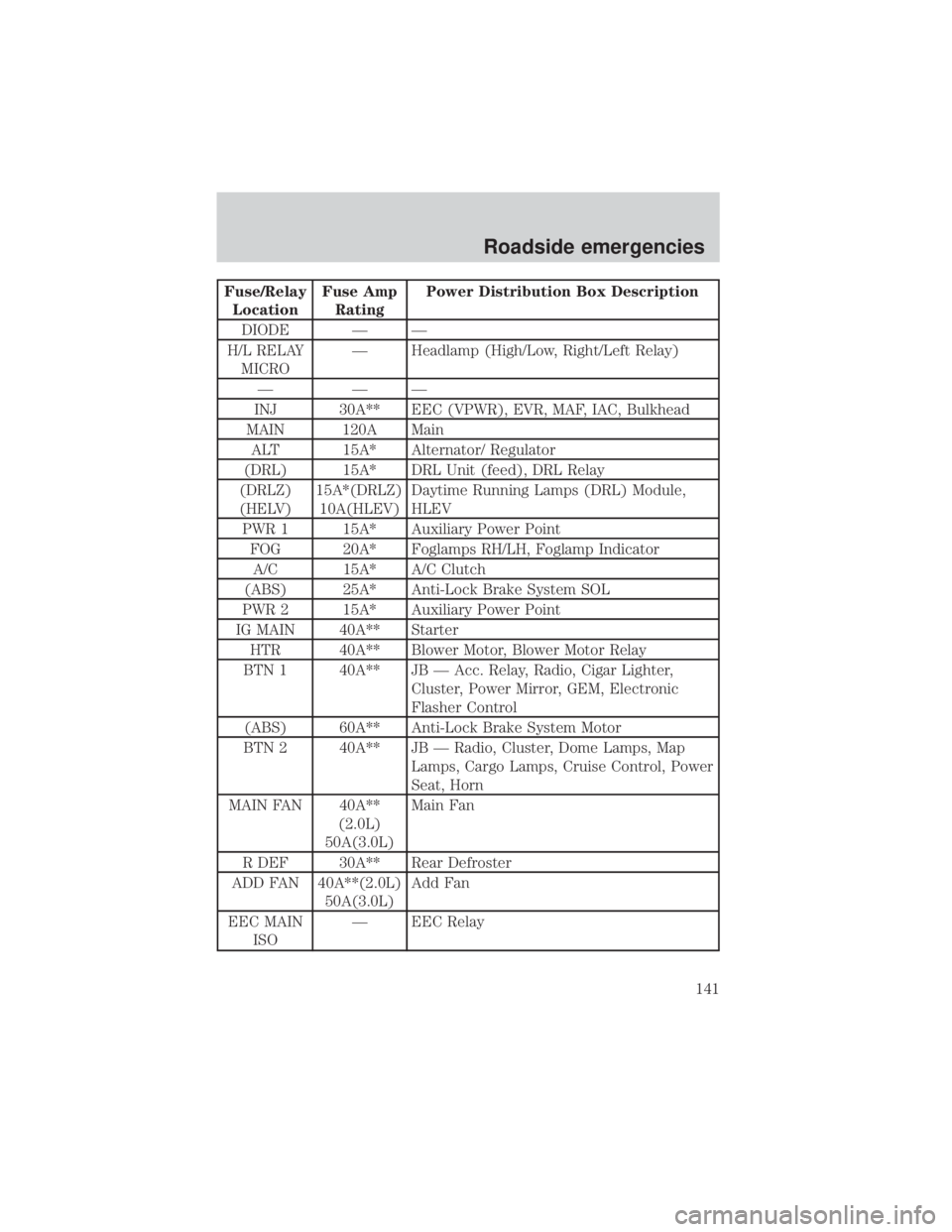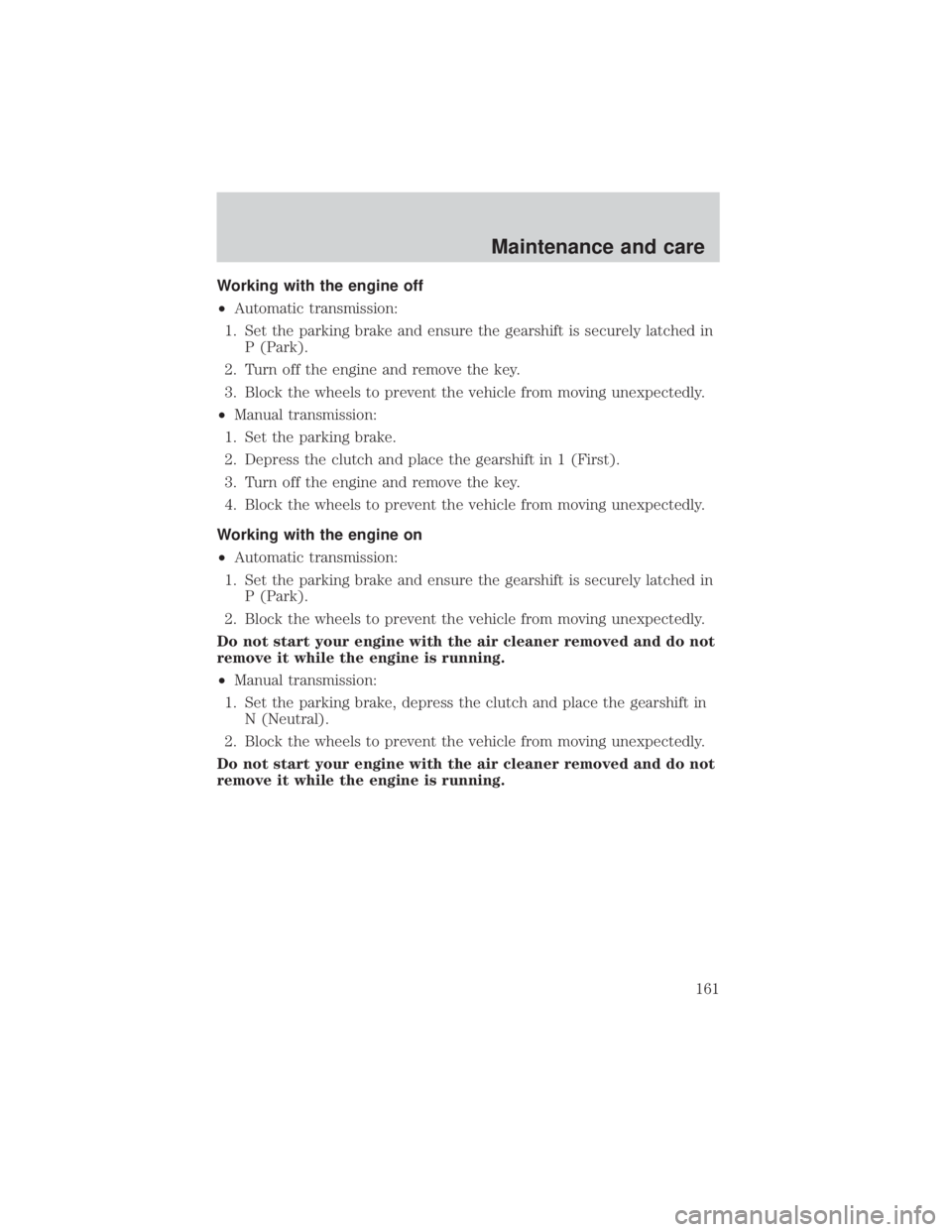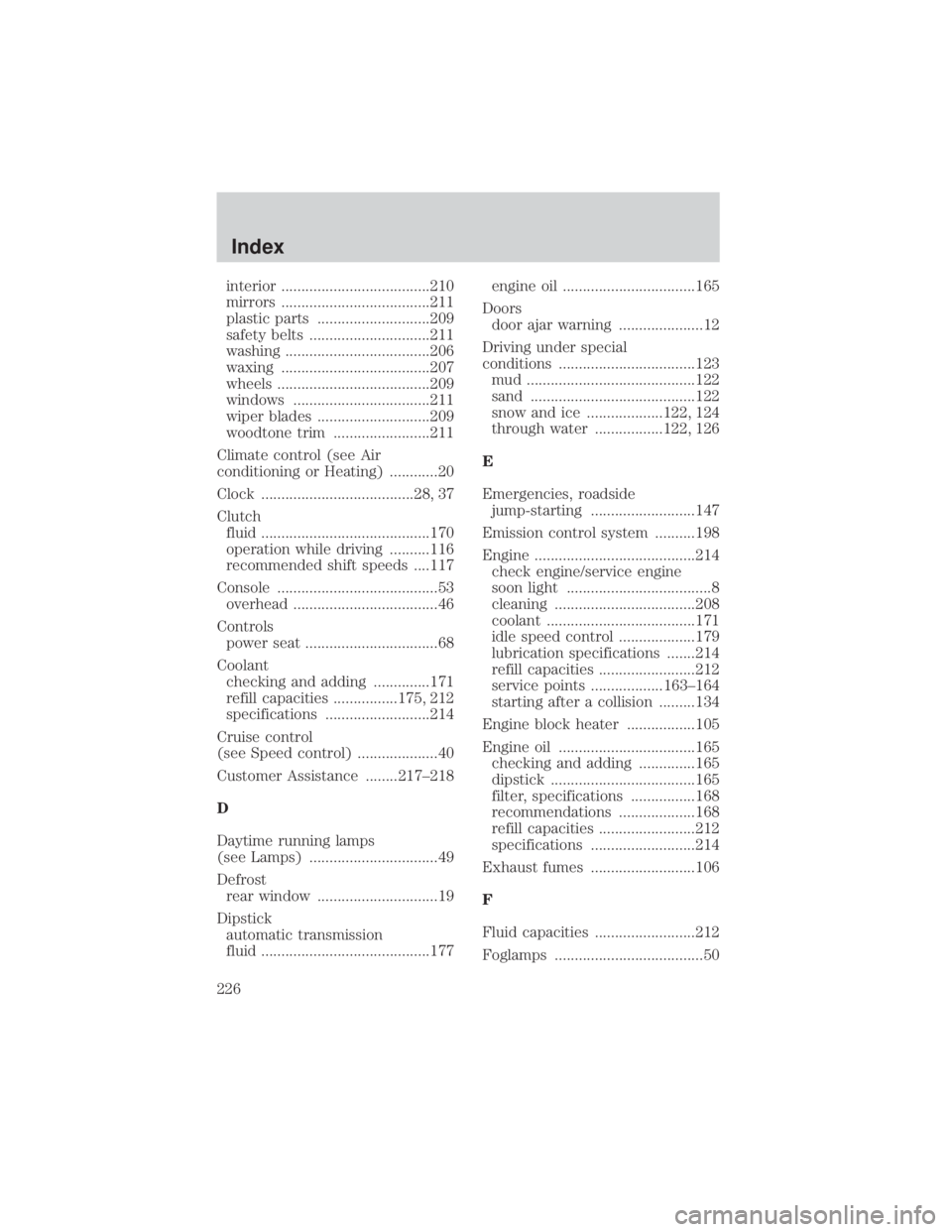clutch MAZDA MODEL TRIBUTE 4WD 2001 Owners Manual
[x] Cancel search | Manufacturer: MAZDA, Model Year: 2001, Model line: MODEL TRIBUTE 4WD, Model: MAZDA MODEL TRIBUTE 4WD 2001Pages: 232, PDF Size: 1.74 MB
Page 11 of 232

WARNING: If the light remains on, continues to flash or fails
to illuminate, have the system serviced immediately. With the
ABS light on, the anti-lock brake system is disabled and normal
braking is still effective unless the brake warning light also
remains illuminated with the parking brake released.
Turn signal
Illuminates when the left or right
turn signal or the hazard lights are
turned on. If one or both of the
indicators stay on continuously or
flash faster, check for a burned-out
turn signal bulb. Refer to Bulbsin the Maintenance and care chapter.
High beams
Illuminates when the high beam
headlamps are turned on.
Speed control
This light comes on when the
vehicle speed control is engaged and
actively controlling the vehicle
speed. It turns off when the speed control OFF or CANCEL controls are
pressed, the brake or clutch (if equipped) is applied or the ignition is
turned to the OFF position after stopping the vehicle.
Anti-theft system
Refer to SecuriLock ypassive
anti-theft system in theControls
and features chapter.
CRUISE
Instrumentation
11
Page 43 of 232

To disengage speed control
²Depress the brake pedal or
² Depress the clutch pedal
(if equipped).
NOTE:Disengaging the speed
control will not erase the previously
programmed set speed.
NOTE:Fully depressing the clutch
pedal may cause a flare in engine
RPM as the throttle is returned to
idle. This is normal.
NOTE:Pressing OFF will erase the
previously programmed set speed.
ON
OFF
Controls and features
43
Page 103 of 232

2. Make sure the headlamps and vehicle accessories are off.
If starting a vehicle with an
automatic transmission:
² Make sure the parking brake is
set.
² Make sure the gearshift is in P
(Park).
If starting a vehicle with a manual
transmission:
² Make sure the parking brake is
set.
² Push the clutch pedal to the
floor.
R D 2 1ODO
Starting
103
Page 116 of 232

1 (First)
Use 1 (First) for when added engine
braking is desired when descending
steep hills.
The automatic transaxle will shift to
the proper gear to ascend any grade
without any need to shift to 1
(First).
To avoid damage to the engine and/or transaxle do not go faster
than 56 km/h (35 mph) when in this gear. You can upshift from 1
(First) to overdrive at any time.WARNING: When parking, do not use the gearshift in place of
the parking brake. Always set the parking brake fully and make
sure that the gearshift is securely latched in Park (P). Turn off
the ignition whenever you leave your vehicle. Never leave your
vehicle unattended while it is running. Never leave children in
an unattended vehicle. If you do not take these precautions,
your vehicle may move unexpectedly and injure someone.
MANUAL TRANSAXLE OPERATION (IF EQUIPPED)
Using the clutch
Vehicles equipped with a manual transaxle have a starter interrupt
interlock that prevents cranking of the engine unless the clutch pedal is
depressed.
When starting a vehicle with a manual transaxle, you must: 1. Put the gearshift lever in the neutral position.
R D 2 1ODO
1
24R 3
5
Driving
116
Page 117 of 232

2. Hold down the brake pedal.
3. Depress the clutch pedal.
4. Without depressing theaccelerator pedal, turn the
ignition to position 4 (START),
release the ignition as soon as
the engine starts.
5. Let the engine idle for a few seconds.
6. Release the brake pedal, then slowly release the clutch pedal
while pressing down slowly on
the accelerator pedal.
Do not drive with your foot resting on the clutch pedal and do
not use the clutch pedal to hold your vehicle at a standstill while
waiting on a hill. These actions will seriously reduce clutch life.
Recommended shift speeds
Upshift according to the following charts for best fuel economy:
Upshifts when accelerating (recommended for best fuel economy)
1-2 22 km/h (14 mph)
2-3 40 km/h (25 mph)
3-4 55 km/h (34 mph)
4-5 70 km/h (44 mph)
Upshifts when cruising (recommended for best fuel economy)
1-2 19 km/h (12 mph)
2-3 31 km/h (19 mph)
3-4 46 km/h (29 mph)
4-5 61 km/h (38 mph)
4
3
2
1
Driving
117
Page 141 of 232

Fuse/RelayLocation Fuse Amp
Rating Power Distribution Box Description
DIODE Ð Ð
H/L RELAY MICRO Ð Headlamp (High/Low, Right/Left Relay)
ÐÐÐ
INJ 30A** EEC (VPWR), EVR, MAF, IAC, Bulkhead
MAIN 120A Main ALT 15A* Alternator/ Regulator
(DRL) 15A* DRL Unit (feed), DRL Relay
(DRLZ)
(HELV) 15A*(DRLZ)
10A(HLEV) Daytime Running Lamps (DRL) Module,
HLEV
PWR 1 15A* Auxiliary Power Point FOG 20A* Foglamps RH/LH, Foglamp IndicatorA/C 15A* A/C Clutch
(ABS) 25A* Anti-Lock Brake System SOL
PWR 2 15A* Auxiliary Power Point
IG MAIN 40A** Starter HTR 40A** Blower Motor, Blower Motor Relay
BTN 1 40A** JB Ð Acc. Relay, Radio, Cigar Lighter, Cluster, Power Mirror, GEM, Electronic
Flasher Control
(ABS) 60A** Anti-Lock Brake System Motor
BTN 2 40A** JB Ð Radio, Cluster, Dome Lamps, Map Lamps, Cargo Lamps, Cruise Control, Power
Seat, Horn
MAIN FAN 40A** (2.0L)
50A(3.0L) Main Fan
R DEF 30A** Rear Defroster
ADD FAN 40A**(2.0L) 50A(3.0L)Add Fan
EEC MAIN ISO Ð EEC Relay
Roadside emergencies
141
Page 142 of 232

Fuse/RelayLocation Fuse Amp
Rating Power Distribution Box Description
FUEL
PUMP ISO Ð Fuel Pump Relay
MAIN FAN ISO Ð Low Speed Fan Control Relay
(2.0L Engine)
High Speed Fan Control Relay 1
(3.0L Engine)
ADD FAN ISO Ð High Speed Fan Control Relay 1
(2.0L Engine)
Low Speed Fan Control Relay
(3.0L Engine)
DEF RELAY ISO Ð Rear Defroster Relay
ST RELAY ISO Ð Starter Relay
ADD FAN 2 ISO Ð High Speed Fan Control Relay 2
(3.0L Engine)
Medium Speed Fan Control Relay
(2.0L Engine)
FOG RELAY MICRO Ð Foglamp Relay
A/C RELAY MICRO Ð A/C Clutch Relay
CHANGING THE TIRES
If you get a flat tire while driving, do not apply the brake heavily.
Instead, gradually decrease your speed. Hold the steering wheel firmly
and slowly move to a safe place on the side of the road.
Temporary spare tire information
Your vehicle may have a temporary or conventional spare tire. The
temporary spare tire for your vehicle is labeled as such. It is smaller than
a regular tire and is designed for emergency use only. Replace this tire
with a full-size tire as soon as possible.
Roadside emergencies
142
Page 161 of 232

Working with the engine off
²Automatic transmission:
1. Set the parking brake and ensure the gearshift is securely latched in P (Park).
2. Turn off the engine and remove the key.
3. Block the wheels to prevent the vehicle from moving unexpectedly.
² Manual transmission:
1. Set the parking brake.
2. Depress the clutch and place the gearshift in 1 (First).
3. Turn off the engine and remove the key.
4. Block the wheels to prevent the vehicle from moving unexpectedly.
Working with the engine on
² Automatic transmission:
1. Set the parking brake and ensure the gearshift is securely latched in P (Park).
2. Block the wheels to prevent the vehicle from moving unexpectedly.
Do not start your engine with the air cleaner removed and do not
remove it while the engine is running.
² Manual transmission:
1. Set the parking brake, depress the clutch and place the gearshift in N (Neutral).
2. Block the wheels to prevent the vehicle from moving unexpectedly.
Do not start your engine with the air cleaner removed and do not
remove it while the engine is running.
Maintenance and care
161
Page 170 of 232

WARNING: Do not let the fluid level in the reservoir for the
master cylinder fall below the MIN mark. If master cylinder
runs dry, this may cause the brakes to fail.
CLUTCH FLUID (MANUAL TRANSAXLE)
The clutch master cylinder and
brake master cylinder are part of
the same system; both are refillable
through the brake master cylinder
with brake fluid. For more
information on brake fluid
maintenance, refer to Brake fluidin
this chapter.
WARNING: Brake fluid is toxic. If brake fluid contacts the
eyes, flush eyes with running water for 15 minutes. Seek
medical if irritation persists. If taken internally, drink water
and induce vomiting. Seek medical attention immediately.
WINDSHIELD WASHER FLUID
Checking and adding washer fluid
Check the washer fluid whenever
you stop for fuel. The reservoir is
highlighted with a
symbol.
If the level is low, add enough fluid
to fill the reservoir. In very cold
weather, do not fill the reservoir all
the way.
Only use a washer fluid that meets Mazda specifications. Refer to
Lubricant specifications in theCapacities and specifications chapter.
Maintenance and care
170
Page 226 of 232

interior .....................................210
mirrors .....................................211
plastic parts ............................209
safety belts ..............................211
washing ....................................206
waxing .....................................207
wheels ......................................209
windows ..................................211
wiper blades ............................209
woodtone trim ........................211
Climate control (see Air
conditioning or Heating) ............20
Clock ......................................28, 37
Clutch fluid ..........................................170
operation while driving ..........116
recommended shift speeds ....117
Console ........................................53 overhead ....................................46
Controls power seat .................................68
Coolant checking and adding ..............171
refill capacities ................175, 212
specifications ..........................214
Cruise control
(see Speed control) ....................40
Customer Assistance ........217±218
D
Daytime running lamps
(see Lamps) ................................49
Defrost rear window ..............................19
Dipstick automatic transmission
fluid ..........................................177 engine oil .................................165
Doors door ajar warning .....................12
Driving under special
conditions ..................................123 mud ..........................................122
sand .........................................122
snow and ice ...................122, 124
through water .................122, 126
E
Emergencies, roadside jump-starting ..........................147
Emission control system ..........198
Engine ........................................214 check engine/service engine
soon light ....................................8
cleaning ...................................208
coolant .....................................171
idle speed control ...................179
lubrication specifications .......214
refill capacities ........................212
service points ..................163±164
starting after a collision .........134
Engine block heater .................105
Engine oil ..................................165 checking and adding ..............165
dipstick ....................................165
filter, specifications ................168
recommendations ...................168
refill capacities ........................212
specifications ..........................214
Exhaust fumes ..........................106
F
Fluid capacities .........................212
Foglamps .....................................50
Index
226